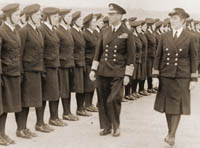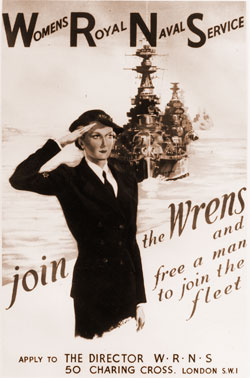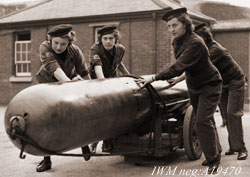
The Wrens - Women's Royal Naval Service


A recruiting poster for the Wrens

 |
|||||||||||||||||||
The Wrens - Women's Royal Naval Service |
|||||||||||||||||||
| The Wrens advertising posters read 'Join the Wrens and free a man for the fleet'. There were some 74,000 Wrens by the end of the war, doing a wide variety of jobs that had previously been done by men. However, unlike the other services, the WRNS did not give women the same pay and status as men. Women were not allowed on the ships, which went into active service, but they did command and crew the powerful harbour launches, often going out in all weathers to collect people from landing craft that were anchored at sea. The boat crews also served as coastal mine-spotters, an important if dangerous job. | |||||||||||||||||||
 |
|||||||||||||||||||
 A recruiting poster for the Wrens |
|||||||||||||||||||
| They were involved in loading torpedoes onto submarines and in plotting battle progress in operations rooms. Wrens trained as welders and carpenters, maintaining and repairing ships in naval bases. They did office work, learnt communications and signalling, weather forecasting (meteorology), engineering, driving, mechanics and radar operating. As with the ATS and the WAAF, women from all backgrounds learnt skills and performed tasks that would have been unheard of before the war, working both in Britain and at naval bases abroad. | |||||||||||||||||||
 |
|||||||||||||||||||
| One such Wren was Mrs Hamnett. She served abroad during World War II. Click here for access to her memories, with links to video and audio clips. | |||||||||||||||||||
| Wrens loading a torpedo onto a submarine | |||||||||||||||||||